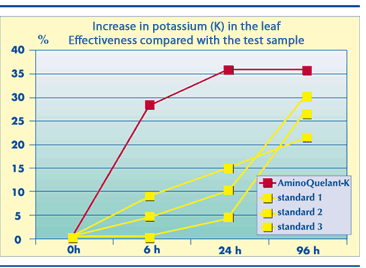AminoQuelant®-K favors a greater absorption and translocation of Potassium
The great speed with which Potassium assimilates after applying AminoQuelant-K is caused by the effect of combining it with L-α-amino acids
The great speed with which Potassium assimilates after applying AminoQuelant-K is caused by the effect of combining it with L-α-amino acids. Most of the potassium is transported inside the plant using the potassium channels that can be found in the cellular membranes. Translocation could be, depending on circumstances, passive (simply by diffusion) or active (when the plant consumes energy). Active transport of potassium is done through potassium pumps which augment absorption, especially when in an environment of unfavourable osmotic gradient.
These channels or pores are formed by membrane proteins that change their configuration from open to closed depending of the amino acids sequence with which the channel combines itself. According to the channel conformation, the speed of absorption and transport of potassium can be increased up to 10,000 times. Application of L- α-amino acids facilitates the open conformation for these channels and, therefore, results in higher absorption and transport speed for the potassium.
This had been demonstrated in several tests analyzing the potassium content after applying several solutions containing potassium, where it has been observed that there is a faster absorption in the plants treated with AminoQuelant-K.

Figure 1. Increase in potassium (K) in the leaf after three solution of potassium, as compared with the test sample with AminoQuelant-K. Cultivation: tomato (Durinta variety).